Statistics
copy to come from copywriter for review
Monographs on Statistics and Applied Probability 143
Statistical Learning
with Sparsity
The Lasso and
Generalizations
143
S
t
a
t
i
s
t
i
c
a
l
L
e
a
r
n
i
n
g
w
i
t
h
S
p
a
r
s
i
t
y
H
a
s
t
i
e
•
T
i
b
s
h
i
r
a
n
i
•
W
a
n
w
i
K25103
r
i
g
h
t
w w w . c r c p r e s s . c o m
Trevor Hastie
Robert Tibshirani
Martin Wainwright
K25103_cover.indd 1
2/24/15 1:35 PM
�
To our parents:
Valerie and Patrick Hastie
Vera and Sami Tibshirani
Patricia and John Wainwright
and to our families:
Samantha, Timothy, and Lynda
Charlie, Ryan, Jess, Julie, and Cheryl
Haruko and Hana
�
�
Contents
Preface
1 Introduction
2 The Lasso for Linear Models
Introduction
2.1
2.2 The Lasso Estimator
2.3 Cross-Validation and Inference
2.4 Computation of the Lasso Solution
Single Predictor: Soft Thresholding
2.4.1
2.4.2 Multiple Predictors: Cyclic Coordinate Descent
2.4.3
Soft-Thresholding and Orthogonal Bases
2.5 Degrees of Freedom
2.6 Uniqueness of the Lasso Solutions
2.7 A Glimpse at the Theory
2.8 The Nonnegative Garrote
2.9
2.10 Some Perspective
Exercises
‘q Penalties and Bayes Estimates
3 Generalized Linear Models
Introduction
3.1
3.2 Logistic Regression
3.2.1 Example: Document Classification
3.2.2 Algorithms
3.3 Multiclass Logistic Regression
3.3.1 Example: Handwritten Digits
3.3.2 Algorithms
3.3.3 Grouped-Lasso Multinomial
3.4 Log-Linear Models and the Poisson GLM
3.4.1 Example: Distribution Smoothing
3.5 Cox Proportional Hazards Models
3.5.1 Cross-Validation
3.5.2 Pre-Validation
3.6 Support Vector Machines
3.6.1 Logistic Regression with Separable Data
ix
xv
1
7
7
8
13
14
15
15
17
17
19
20
20
22
23
24
29
29
31
32
35
36
37
39
39
40
40
42
43
45
46
49
�
x
3.7 Computational Details and glmnet
Bibliographic Notes
Exercises
4 Generalizations of the Lasso Penalty
Introduction
4.1
4.2 The Elastic Net
4.3 The Group Lasso
4.3.1 Computation for the Group Lasso
4.3.2
4.3.3 The Overlap Group Lasso
Sparse Group Lasso
4.4 Sparse Additive Models and the Group Lasso
Sparse Additive Models and Backfitting
4.4.1 Additive Models and Backfitting
4.4.2
4.4.3 Approaches Using Optimization and the Group Lasso
4.4.4 Multiple Penalization for Sparse Additive Models
5.2.1 Optimality for Differentiable Problems
5.2.2 Nondifferentiable Functions and Subgradients
5.3 Gradient Descent
5.3.1 Unconstrained Gradient Descent
5.3.2 Projected Gradient Methods
5.3.3 Proximal Gradient Methods
5.3.4 Accelerated Gradient Methods
5.4 Coordinate Descent
Separability and Coordinate Descent
5.4.1
5.4.2 Linear Regression and the Lasso
5.4.3 Logistic Regression and Generalized Linear Models
5.5 A Simulation Study
5.6 Least Angle Regression
5.7 Alternating Direction Method of Multipliers
4.5 The Fused Lasso
4.5.1 Fitting the Fused Lasso
4.5.1.1 Reparametrization
4.5.1.2 A Path Algorithm
4.5.1.3 A Dual Path Algorithm
4.5.1.4 Dynamic Programming for the Fused Lasso
4.5.2 Trend Filtering
4.5.3 Nearly Isotonic Regression
4.6 Nonconvex Penalties
Bibliographic Notes
Exercises
5 Optimization Methods
Introduction
5.1
5.2 Convex Optimality Conditions
50
52
53
55
55
56
58
62
64
65
69
69
70
72
74
76
77
78
79
79
80
81
83
84
86
88
95
95
95
95
98
100
101
102
103
107
109
110
112
115
117
118
121
�
5.8 Minorization-Maximization Algorithms
5.9 Biconvexity and Alternating Minimization
5.10 Screening Rules
Bibliographic Notes
Appendix
Exercises
6 Statistical Inference
6.1 The Bayesian Lasso
6.2 The Bootstrap
6.3 Post-Selection Inference for the Lasso
6.3.1 The Covariance Test
6.3.2 A General Scheme for Post-Selection Inference
6.3.2.1 Fixed-λ Inference for the Lasso
6.3.2.2 The Spacing Test for LAR
6.3.3 What Hypothesis Is Being Tested?
6.3.4 Back to Forward Stepwise Regression
Inference via a Debiased Lasso
6.4
6.5 Other Proposals for Post-Selection Inference
Bibliographic Notes
Exercises
xi
123
124
127
131
132
134
139
139
142
147
147
150
154
156
157
158
158
160
161
162
Introduction
7.1
7.2 The Singular Value Decomposition
7.3 Missing Data and Matrix Completion
7.3.1 The Netflix Movie Challenge
7.3.2 Matrix Completion Using Nuclear Norm
7.3.3 Theoretical Results for Matrix Completion
7.3.4 Maximum Margin Factorization and Related Methods
7 Matrix Decompositions, Approximations, and Completion 167
167
169
169
170
174
177
181
184
185
187
190
195
196
7.4 Reduced-Rank Regression
7.5 A General Matrix Regression Framework
7.6 Penalized Matrix Decomposition
7.7 Additive Matrix Decomposition
Bibliographic Notes
Exercises
8 Sparse Multivariate Methods
Introduction
8.1
8.2 Sparse Principal Components Analysis
8.2.1
8.2.2
Some Background
Sparse Principal Components
8.2.2.1
Sparsity from Maximum Variance
8.2.2.2 Methods Based on Reconstruction
8.2.3 Higher-Rank Solutions
201
201
202
202
204
204
206
207
�
xii
Illustrative Application of Sparse PCA
8.2.3.1
Sparse PCA via Fantope Projection
Sparse Autoencoders and Deep Learning
Some Theory for Sparse PCA
8.3 Sparse Canonical Correlation Analysis
8.2.4
8.2.5
8.2.6
8.3.1 Example: Netflix Movie Rating Data
8.4 Sparse Linear Discriminant Analysis
8.4.1 Normal Theory and Bayes’ Rule
8.4.2 Nearest Shrunken Centroids
8.4.3 Fisher’s Linear Discriminant Analysis
8.4.3.1 Example: Simulated Data with Five Classes
8.4.4 Optimal Scoring
8.4.4.1 Example: Face Silhouettes
8.5 Sparse Clustering
8.5.1
Some Background on Clustering
8.5.1.1 Example: Simulated Data with Six Classes
Sparse Hierarchical Clustering
Sparse K-Means Clustering
8.5.2
8.5.3
8.5.4 Convex Clustering
Bibliographic Notes
Exercises
9 Graphs and Model Selection
Introduction
9.1
9.2 Basics of Graphical Models
9.2.1 Factorization and Markov Properties
9.2.1.1 Factorization Property
9.2.1.2 Markov Property
9.2.1.3 Equivalence of Factorization and Markov
Properties
9.2.2
Some Examples
9.2.2.1 Discrete Graphical Models
9.2.2.2 Gaussian Graphical Models
9.3 Graph Selection via Penalized Likelihood
9.3.1 Global Likelihoods for Gaussian Models
9.3.2 Graphical Lasso Algorithm
9.3.3 Exploiting Block-Diagonal Structure
9.3.4 Theoretical Guarantees for the Graphical Lasso
9.3.5 Global Likelihood for Discrete Models
9.4 Graph Selection via Conditional Inference
9.4.1 Neighborhood-Based Likelihood for Gaussians
9.4.2 Neighborhood-Based Likelihood for Discrete Models
9.4.3 Pseudo-Likelihood for Mixed Models
9.5 Graphical Models with Hidden Variables
Bibliographic Notes
209
210
210
212
213
215
217
217
218
221
222
225
226
227
227
228
228
230
231
232
234
241
241
241
241
242
243
243
244
244
245
246
247
248
251
252
253
254
255
256
259
261
261
�
Exercises
10 Signal Approximation and Compressed Sensing
10.1 Introduction
10.2 Signals and Sparse Representations
10.2.1 Orthogonal Bases
10.2.2 Approximation in Orthogonal Bases
10.2.3 Reconstruction in Overcomplete Bases
10.3 Random Projection and Approximation
10.3.1 Johnson–Lindenstrauss Approximation
10.3.2 Compressed Sensing
10.4 Equivalence between ‘0 and ‘1 Recovery
10.4.1 Restricted Nullspace Property
10.4.2 Sufficient Conditions for Restricted Nullspace
10.4.3 Proofs
10.4.3.1 Proof of Theorem 10.1
10.4.3.2 Proof of Proposition 10.1
Bibliographic Notes
Exercises
11 Theoretical Results for the Lasso
11.1 Introduction
11.1.1 Types of Loss Functions
11.1.2 Types of Sparsity Models
11.2 Bounds on Lasso ‘2-Error
11.2.1 Strong Convexity in the Classical Setting
11.2.2 Restricted Eigenvalues for Regression
11.2.3 A Basic Consistency Result
11.3 Bounds on Prediction Error
11.4 Support Recovery in Linear Regression
11.4.1 Variable-Selection Consistency for the Lasso
11.4.1.1 Some Numerical Studies
11.4.2 Proof of Theorem 11.3
11.5 Beyond the Basic Lasso
Bibliographic Notes
Exercises
Bibliography
Author Index
Index
xiii
263
269
269
269
269
271
274
276
277
278
280
281
282
284
284
284
285
286
289
289
289
290
291
291
293
294
299
301
301
303
305
310
311
312
315
337
343
�



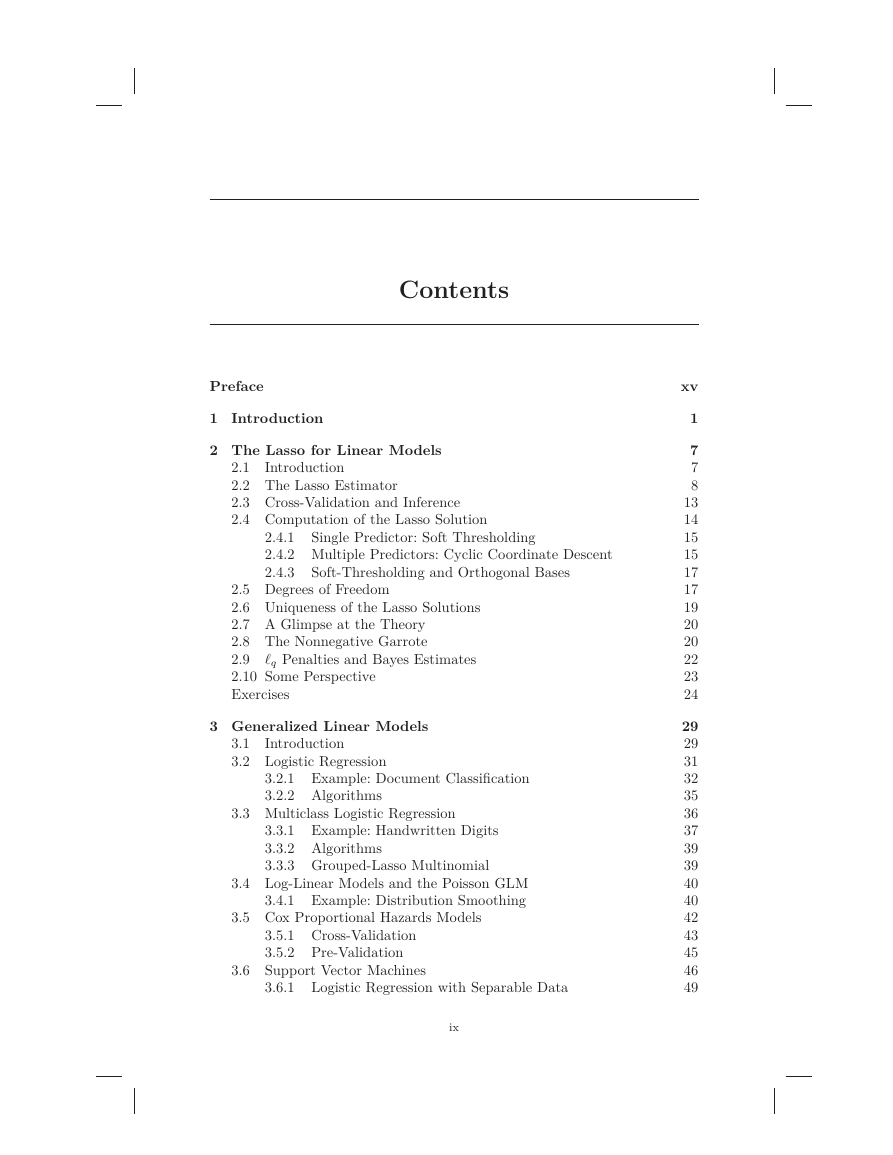
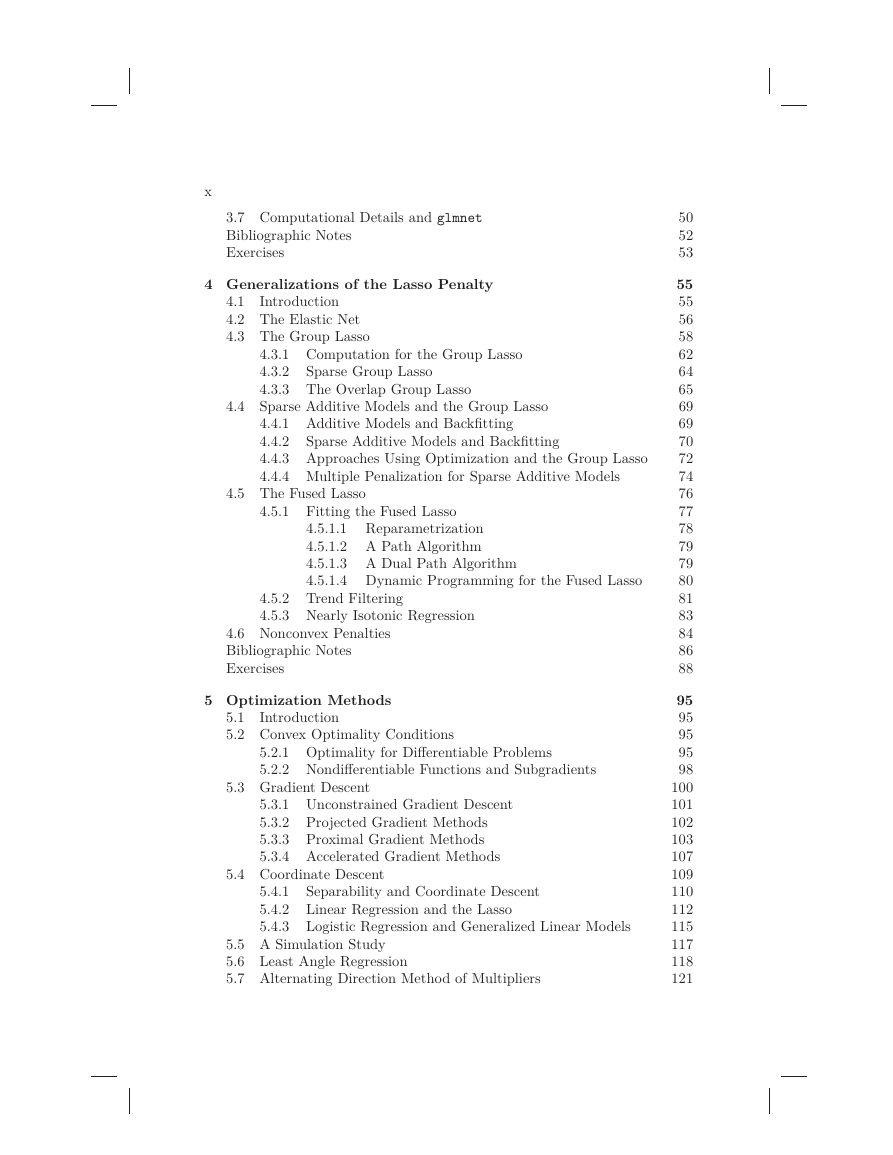
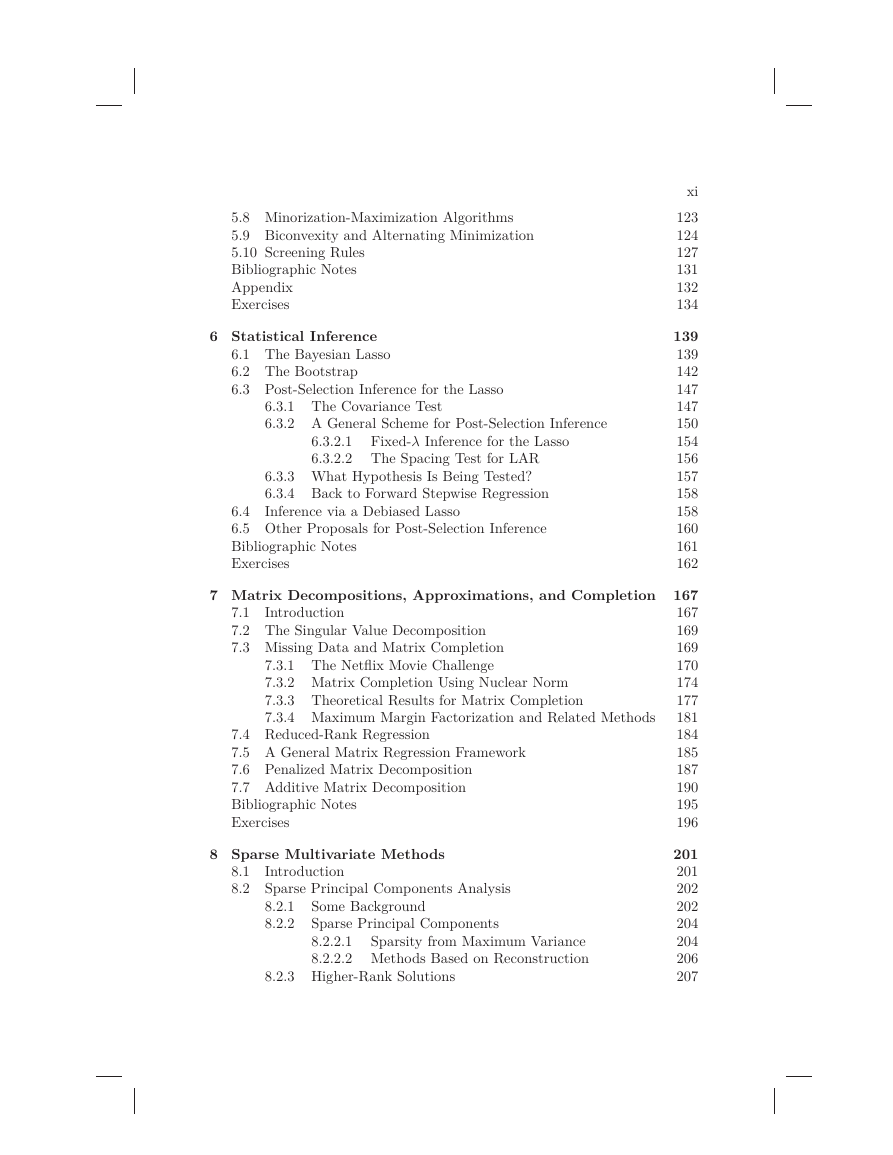
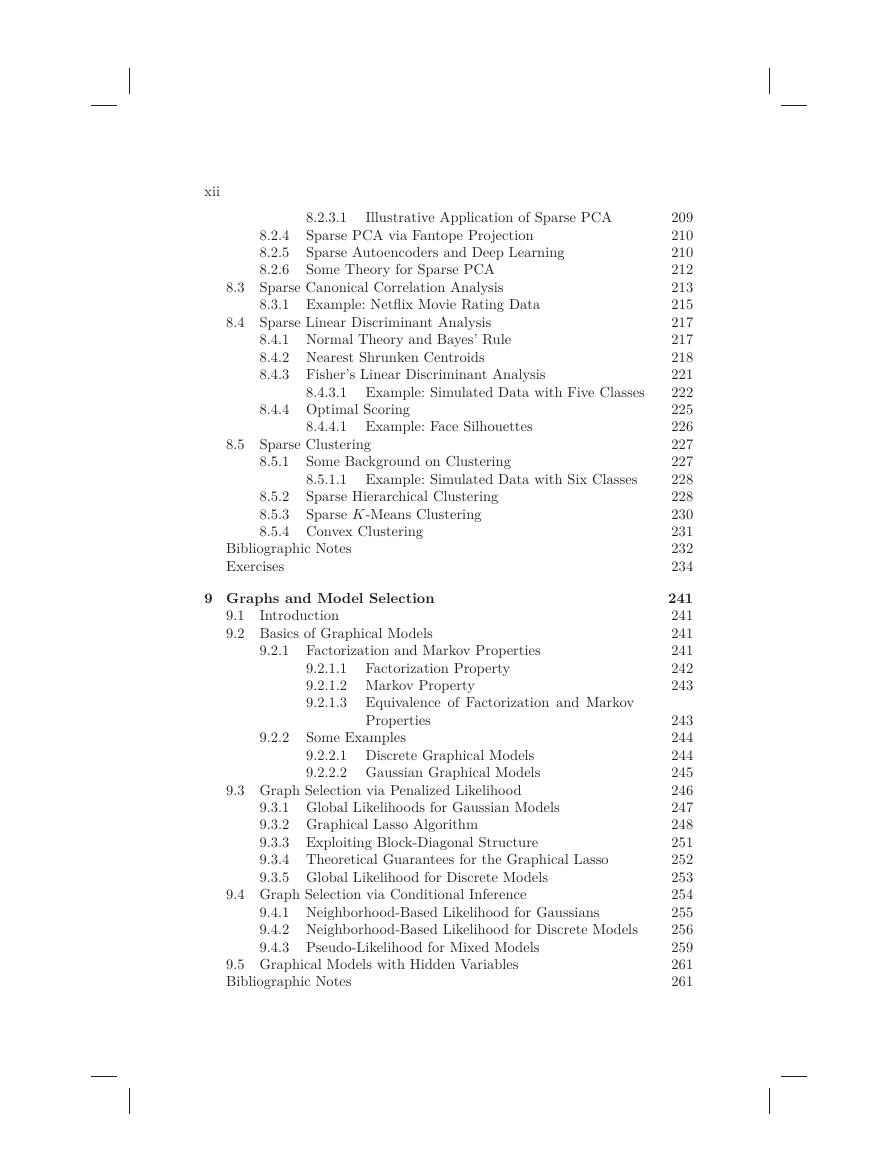
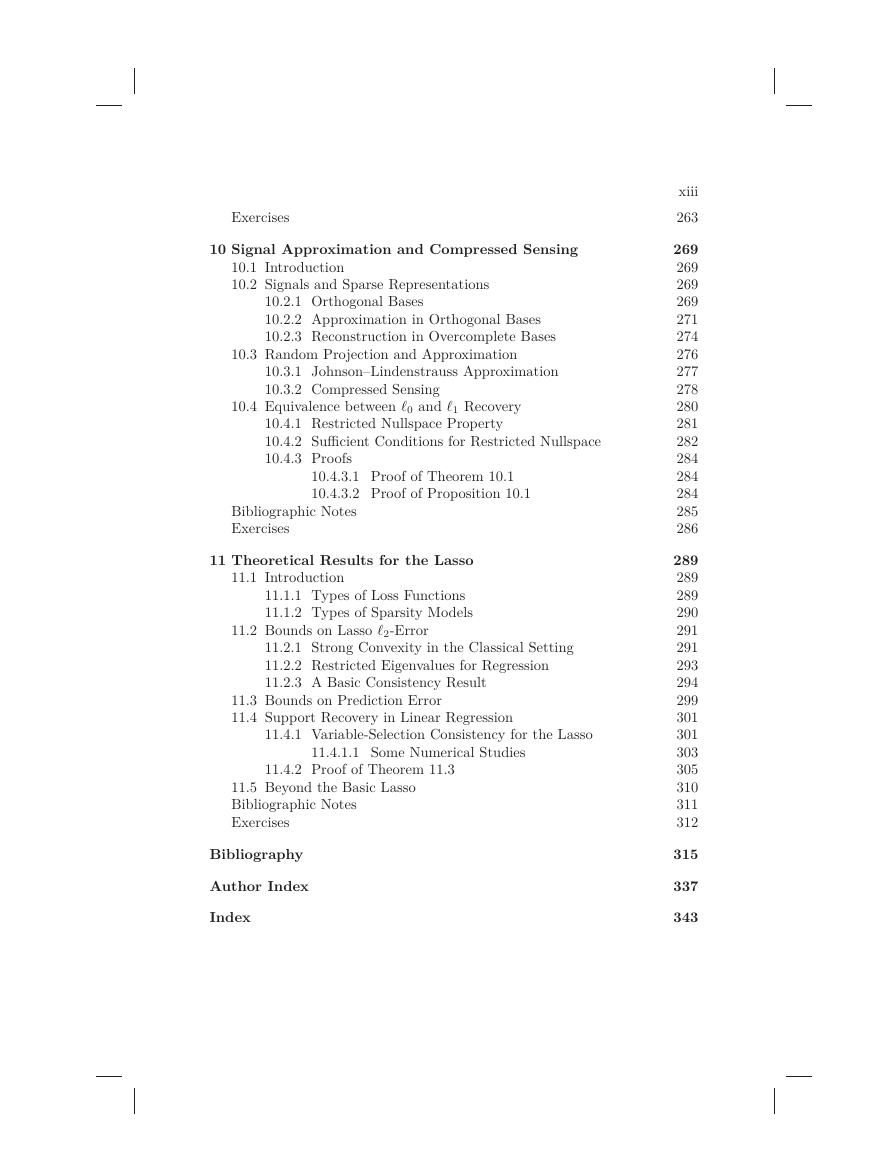








 2023年江西萍乡中考道德与法治真题及答案.doc
2023年江西萍乡中考道德与法治真题及答案.doc 2012年重庆南川中考生物真题及答案.doc
2012年重庆南川中考生物真题及答案.doc 2013年江西师范大学地理学综合及文艺理论基础考研真题.doc
2013年江西师范大学地理学综合及文艺理论基础考研真题.doc 2020年四川甘孜小升初语文真题及答案I卷.doc
2020年四川甘孜小升初语文真题及答案I卷.doc 2020年注册岩土工程师专业基础考试真题及答案.doc
2020年注册岩土工程师专业基础考试真题及答案.doc 2023-2024学年福建省厦门市九年级上学期数学月考试题及答案.doc
2023-2024学年福建省厦门市九年级上学期数学月考试题及答案.doc 2021-2022学年辽宁省沈阳市大东区九年级上学期语文期末试题及答案.doc
2021-2022学年辽宁省沈阳市大东区九年级上学期语文期末试题及答案.doc 2022-2023学年北京东城区初三第一学期物理期末试卷及答案.doc
2022-2023学年北京东城区初三第一学期物理期末试卷及答案.doc 2018上半年江西教师资格初中地理学科知识与教学能力真题及答案.doc
2018上半年江西教师资格初中地理学科知识与教学能力真题及答案.doc 2012年河北国家公务员申论考试真题及答案-省级.doc
2012年河北国家公务员申论考试真题及答案-省级.doc 2020-2021学年江苏省扬州市江都区邵樊片九年级上学期数学第一次质量检测试题及答案.doc
2020-2021学年江苏省扬州市江都区邵樊片九年级上学期数学第一次质量检测试题及答案.doc 2022下半年黑龙江教师资格证中学综合素质真题及答案.doc
2022下半年黑龙江教师资格证中学综合素质真题及答案.doc